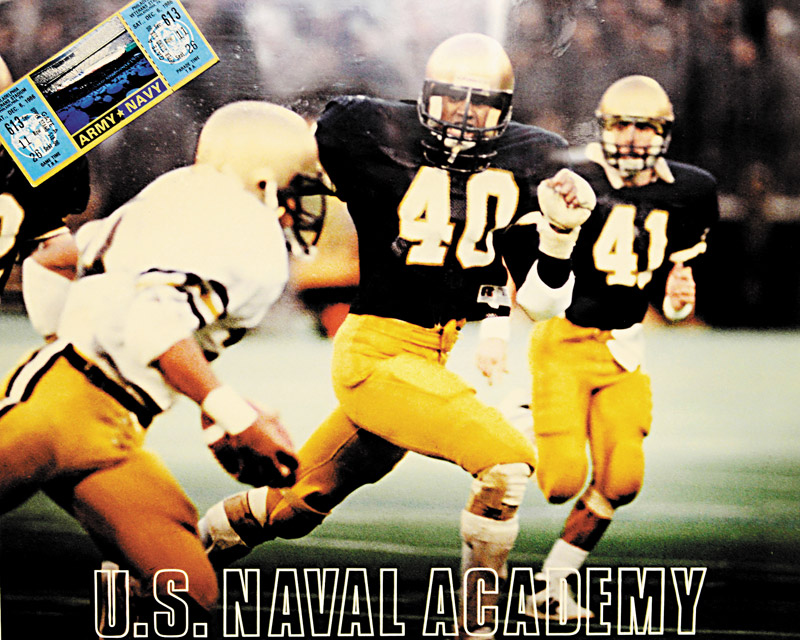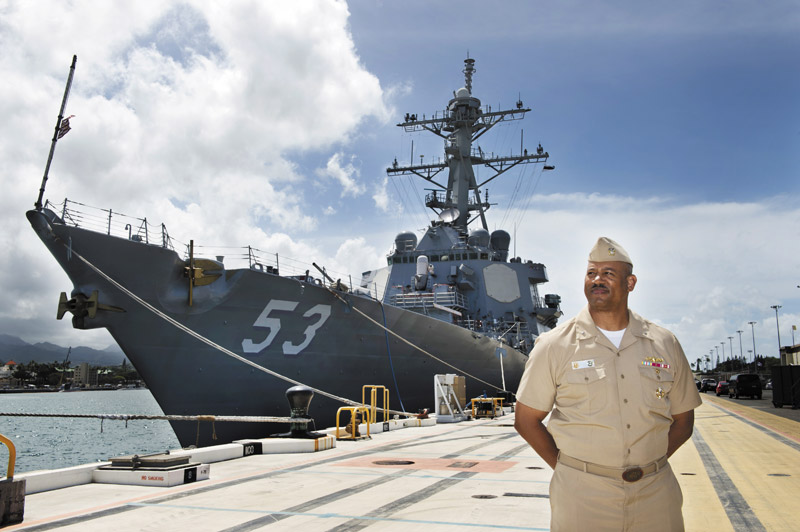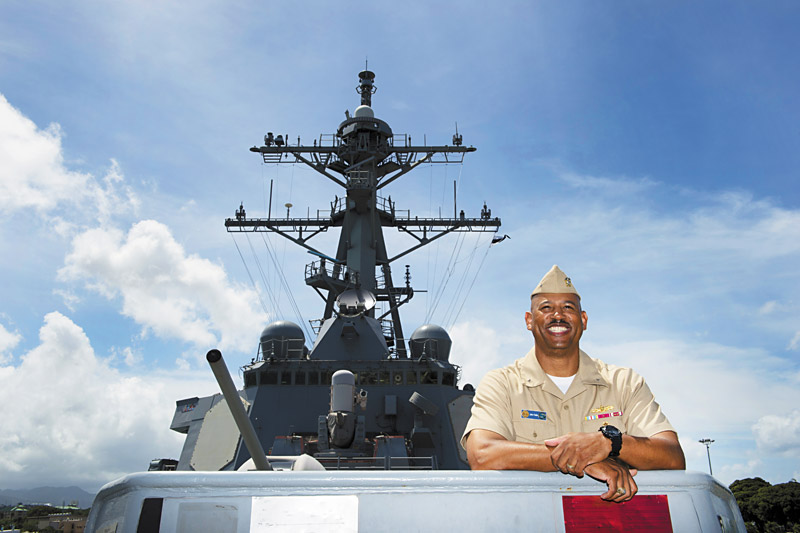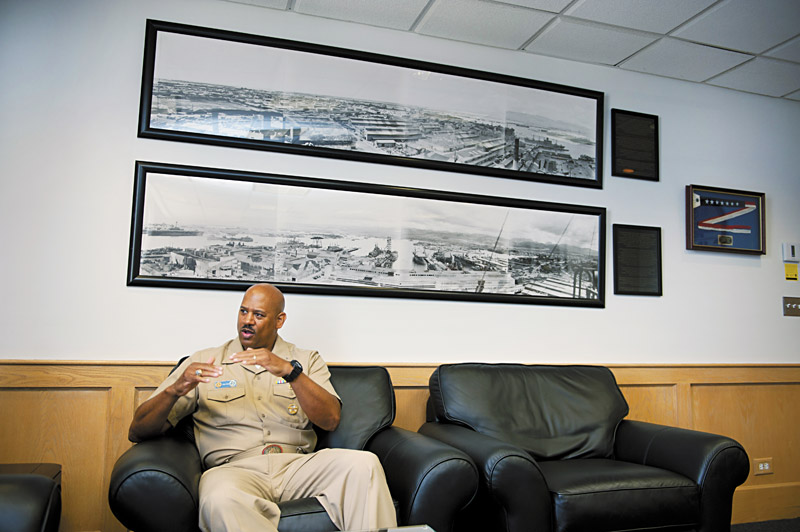Keeping Hawaii’s Navy Shipshape
He won’t be commanding a ship when RIMPAC begins this week, but as commander Navy Region Hawaii and commander Naval Surface Group, Middle Pacific, Rear Adm. John Fuller will help make sure everything runs smoothly for the world’s biggest cooperative maritime exercise
Historically, battles are fought on land, by sea and in the air. But instead of raging war on earth’s surfaces, the biennial Rim of the Pacific (RIMPAC) exercise brings together international forces in Pacific waters in the spirit of collaboration and brotherhood.
The world’s largest maritime exercise celebrates its 25th anniversary in Hawaii and southern California June 30-Aug. 4, and, this year, operates under the theme of “Capable, Adaptive, Partners.”
Hosted by U.S. Pacific Fleet, RIMPAC 2016 will welcome around 40 ships, 200 aircraft and tens of thousands of personnel from 26 countries. With all the hustle and bustle RIMPAC will bring, it’s essential to have teams in place to ensure everything goes smoothly.
Behind the logistics and support for RIMPAC is Rear Adm. John Fuller, who holds dual titles of commander Navy Region Hawaii and commander Naval Surface Group, Middle Pacific. It’s a unique combination of responsibilities.
The former role, Fuller compares to the Tony Awards — war fighters are the actors and actresses on stage, and his command provides all the support to ensure the production is successful, like the production crew and stage hands. He is responsible for two major installations: Joint Base Pearl Harbor-Hickam and Pacific Missile Range Facility Barking Sands on Kauai.
“What we provide are the facilities — the fire, police, piers, MWRs, electricity — all the support that makes everything else work,” he says. “We’re here doing all the day-to-day things that you just expect to happen.”
Or, speaking from his football days at the Naval Academy — he received his commission in 1987 — “We are the linemen.”
During the 2007 season, Fuller jumped on board with the Naval Academy football team as liaison between players and the Navy, and was there for Ken Niumatalolo’s inaugural season as head coach — an assistant in 2007, he was named Navy’s head coach just before the Midshipmen’s 2007 bowl game.
And from his experiences with the Laie-born UH football standout, Fuller gained a broader perspective on what it means to be a leader.
“The thing I like about him (Niumatalolo) is his morals and ethics,” Fuller says. “He’s been loyal to the right things, and that ethos just speaks volumes to the
character in the people he’s helping to grow. As a Navy officer and flag officer, I want to be able to do the same things, and build a program that develops people and has a long-term process.”
Fuller’s command position with Naval Surface Group, Middle Pacific sees him act as executive agent of commander, Naval Surface Forces Vice Adm. Thomas Rowden. As command, Fuller is responsible for maintenance and training of nearly a dozen surface ships home-ported in Joint Base Pearl Harbor-Hickam. One of the ships Fuller oversees, USS Chung-Hoon (named after the first Native Hawaiian and Asian-American Navy admiral) soon will return from deployment after more than a year in the Western Pacific.
“I’m empowered to make sure a lot of things go well,” he says, “and I know both sides.”
Nations expected to take part in RIMPAC include returnees Australia, Brunei, Canada, Chile, Colombia, France, India, Indonesia, Japan, Malaysia, Mexico, the Netherlands, New Zealand, Norway, the People’s Republic of China, Peru, the Republic of Korea, the Republic of the Philippines, Singapore, Thailand, Tonga, the United Kingdom and the U.S., as well as first-time participants Denmark, Germany and Italy.
According to U.S. Third Fleet public affairs, “RIMPAC helps participants foster and sustain cooperative relationships that are critical to ensuring the safety of sea lanes and security on the world’s oceans.”
It is this collaborative spirit that, to hear Fuller tell it, is necessary to build security.
“The first time you talk to someone shouldn’t be when things are going bad,” he explains. “So we’re building relationships, establishing rules, norms and procedures. We also want to let them (other countries) see operationally what opportunities there are to train with our military.
“I will say, unequivocally, we are the best in the world, and we will become better by the quality of our friends and how well we work with others.”
He views RIMPAC as a chance for Hawaii to showcase itself as a place of collaboration, commerce and beauty.
“A successful RIMPAC will have ripple effects in the future, where there will be more prosperity, more order, benefiting from the value of having law and order, and free communication and commerce.”
When the exercises come to a close at the end of summer, Fuller still will have to shoulder a lot of responsibilities in his dual commander position.
Aside from his daily obligations, Fuller looks toward the future and how the Navy can continue to prosper and attract valuable individuals to its ranks.
As a professional mariner, he is happy to be in a place that celebrates traditional maritime expeditions and helps support organizations like Polynesian Voyaging Society.
“The fact that they were able to navigate great distances just by looking at the stars, using outriggers, I like drawing the breadcrumbs to what we do now,” he says. “The fact that they could do what they did gives me inspiration that we can do all sorts of things.”
One such area is the organization’s sustainability and green-living efforts. A look around Joint Base Pearl Harbor-Hickam reveals photovoltaic panels atop numerous buildings. But that, says Fuller, is just one way the Navy is attempting to help the environment.
“I’ve personally spent a lot of time trying to figure out how to be smart about energy,” says Fuller, who chairs an energy conservation board once a month. “We look at things like turning off all the lights in the building, and turning off water coolers and water fountains.”
On a bigger scale, RIMPAC remembrance boats will utilize biofuel, which produces less greenhouse gases than fossil fuels.
“It’s amazing, when you scoop together all the things we’re doing and put it in a pile — the amount of effort we’re putting toward environmental safety,” he continues. “If people saw how much that is, they’d be really impressed with the earnest effort we’re putting forth behind being environmentally smart.”
Fuller comes from a family familiar with military service and the sacrifices members make. His parents met in the Army, fell in love and then married in the ’50s, and his grandfather served in the Army during World War I.
“Service was just something I grew up with,” he says. “I thought that’s what everybody did because it was a great way of life.”
Although his grandpa, dad, mom and brother bleed Army black and gold, Fuller chose his own path in the Navy. A nonchalant phrase from a passerby — “Cadets never smile” — solidified his decision to attend the U.S. Naval Academy at Annapolis in 1983, and he quickly found that the Navy life fit his personality extremely well.

The future admiral (40) moves in fast to make a tackle in the 1986 Army-Navy game U.S. NAVAL ACADEMY PHOTO
“And that was it for me,” he says.
Fuller recalls the overwhelming beauty of that Maryland ocean town and the liberating feeling knowing that the Navy had so much to offer in terms of education and travel.
“And the football team was better,” he adds lightheartedly.
Although his dad is an Army man (a retired colonel), Fuller says his parents were supportive with his career choice.
“By going to the Naval Academy I paid for school,” he explains. “They were happy going from black and gold to blue and gold.”
Since receiving his commission from the academy in 1987 (and earning his bachelor’s degree in political science), Fuller went on to obtain a master’s in management from the Naval Post Graduate School, as well as a Master of Arts in National Security and Strategic Studies from the College of Naval Command and Staff at the Naval War College.
He also was chosen as a yearlong Seminar XXI Fellow with Massachusetts Institute of Technology. During that time, he was able to visit campus to focus on international studies. It gave him a chance to learn more about the world and gain a higher level of academic perspective on issues that plague different nations.
“More education creates more opportunities. The thing about education, I discovered, is that it’s selfish,” he says. “Once they give it to you, they can never take it back, and it’s a nice way to invest in yourself.”
In a field dominated primarily by engineeringand science-related majors, Fuller stands by his decision to delve into political science.
“If I’m going to travel the world, it would be nice to understand what they’re thinking,” he explains.
The wanderlust Fuller has for traveling and learning about different people and cultures stems from his youth and traveling with his family.
The open-mindedness and cultural acceptance and fascination are things he wants for his own family. His daughter has moved a total of 10 times, while his son has moved eight times.
“When you move that much, it really makes you appreciate a good family environment,” he says. “It gives them a broader cultural experience, and there are great cultural opportunities to expand on their education. It’s a jewel.”
It has been about a year since Fuller assumed duties as commander Navy Region Hawaii and commander Naval Surface Group, Middle Pacific, and it has been a year of amazing experiences and notable milestones.
In a blog post, he expands on the past Memorial Day lantern-floating event at Ala Moana Beach Park and the Navy’s celebration of LGBT Pride Month for service members and civilians — two occasions he is proud to have been a part.
He also participated in the 70th anniversary celebration for the end of World War II and the fireworks display partnership between the City and County of Honolulu and the city of Nagaoka, and he will assist in the preparation for the history-making 75th anniversary of the attack on Pearl Harbor.
But most of all, “I got to move to Hawaii,” he says. It’s true. The rear admiral has fallen in love with the Islands, the people and, of course, the weather.
“Without a doubt, I would say Hawaii is the most welcoming place I’ve ever been,” he says. “I look out the window and I think, ‘I get to live here.’
“There’s really a sense of community here. It’s very diverse, so there’s no overt sense of racism or any-ism. It’s just a family-oriented place.”








